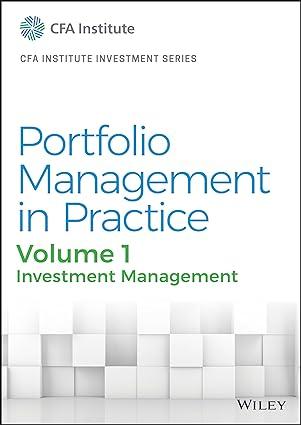Answered step by step
Verified Expert Solution
Question
1 Approved Answer
WAR STORY: THE DANGER OF NOT THINKING THROUGH THE INVESTMENT SIGNALTactical asset allocation ( TAA ) strategies involve timing the markets. The goal is to
WAR STORY: THE DANGER OF NOT THINKING THROUGH THE INVESTMENT SIGNALTactical asset allocation TAA strategies involve timing the markets. The goal is to identify which asset class will outperform in the future and then overweight that asset class in your portfolio. One popular approach is to develop an econometric model based on market variables including trailing returns, dividend yields, and interest rates, as well as macroeconomic data including inflation, production levels, and GDP changes.Consider one strategy that applied a probabilistic approach. The idea was not to forecast future returns but instead to estimate the probability of one asset class outperforming another. A probit statistical model can be used to estimate such a probability. When forecast probability differences were statistically significant, the manager would purchase futures contracts in the asset class expected to outperform and sell futures contracts in other asset classes. The original model was fitted using historical market data and historical economic data released by the federal government. The government frequently releases economic data with a lag. It takes time to tabulate and distribute the information collected from industries and other sources. When estimating an econometric model using historical economic data, the modeler should be careful to include an accurate measure of the time lag expected when the model is implemented. For example, it is important to recognize that the fourth quarter productivity number will be available not on December but more likely four weeks later. There is a general understanding of this issue in the investment business, including the recognition that this time lag may have been longer in the past.What is less understood is that government economic data are subject to several revisions even after they are released. For example, productivity figures are revised weeks and even years after their initial releases. Historical databases may store only the final revision. If you model and test your strategy using these data, you are effectively assuming that you knew the revised numbers before they were released. Think about this: If someone knew how economic data would be revised beforehand, she should be able to make money. Accurate testing requires building and testing the model with the initially released data.Unfortunately the probabilistic TAA strategy just described was built using historical, revised data and implemented in real time with first release data. Initially the strategy seemed to work, but after a few quarters it stopped adding value. During a followup analysis of the strategy, it was observed that forecasts rerun with the historical database months later differed from the original forecasts run months earlier. The original forecasts that were run with firstrelease data lost money when implemented using the model. The rerun forecasts, utilizing subsequently revised data, would have added value had the revisions been known in advance. But run live, they were useless.management
The War Story text boxes that describe real situations in which an investment strategy or approach did or did not work. What did you learn from one of these War Stories? How can you apply that situation to your future investment management process?
Step by Step Solution
There are 3 Steps involved in it
Step: 1

Get Instant Access to Expert-Tailored Solutions
See step-by-step solutions with expert insights and AI powered tools for academic success
Step: 2

Step: 3

Ace Your Homework with AI
Get the answers you need in no time with our AI-driven, step-by-step assistance
Get Started


